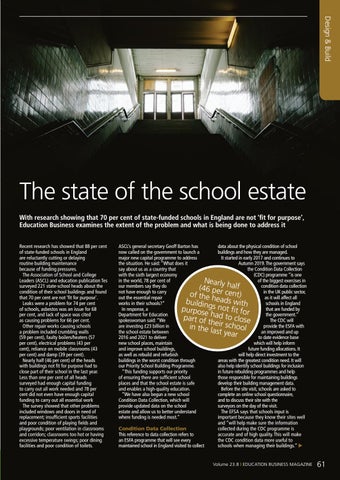Design & Build
The state of the school estate With research showing that 70 per cent of state-funded schools in England are not ‘fit for purpose’, Education Business examines the extent of the problem and what is being done to address it Recent research has showed that 88 per cent of state-funded schools in England are reluctantly cutting or delaying routine building maintenance because of funding pressures. The Association of School and College Leaders (ASCL) and education publication Tes surveyed 221 state-school heads about the condition of their school buildings and found that 70 per cent are not ‘fit for purpose’. Leaks were a problem for 74 per cent of schools, asbestos was an issue for 68 per cent, and lack of space was cited as causing problems for 66 per cent. Other repair works causing schools a problem included crumbling walls (59 per cent), faulty boilers/heaters (57 per cent), electrical problems (43 per cent), reliance on mobile classrooms (43 per cent) and damp (39 per cent). Nearly half (46 per cent) of the heads with buildings not fit for purpose had to close part of their school in the last year. Less than one per cent of all heads surveyed had enough capital funding to carry out all work needed and 78 per cent did not even have enough capital funding to carry out all essential work The survey showed that other problems included windows and doors in need of replacement; insufficient sports facilities and poor condition of playing fields and playgrounds; poor ventilation in classrooms and corridors; classrooms too hot or having excessive temperature swings; poor dining facilities and poor condition of toilets.
ASCL’s general secretary Geoff Barton has data about the physical condition of school now called on the government to launch a buildings and how they are managed. major new capital programme to address It started in early 2017 and continues to the situation. He said: “What does it Autumn 2019. The government says say about us as a country that the Condition Data Collection with the sixth largest economy (CDC) programme “is one in the world, 78 per cent of of the biggest exercises in Nearly h a our members say they do condition data collection l f (46 per not have enough to carry in the UK public sector, c e n of the h t) out the essential repair as it will affect all building eads with works in their schools?” schools in England In response, a that are funded by purpos s not fit for e had t Department for Education the government.” o close part of spokeswoman said: “We The CDC will th are investing £23 billion in provide the ESFA with in the l eir school ast yea the school estate between an improved and up r 2016 and 2021 to deliver to date evidence base new school places, maintain which will help inform and improve school buildings, future funding allocations. It as well as rebuild and refurbish will help direct investment to the buildings in the worst condition through areas with the greatest condition need. It will our Priority School Building Programme. also help identify school buildings for inclusion “This funding supports our priority in future rebuilding programmes and help of ensuring there are sufficient school those responsible for maintaining buildings places and that the school estate is safe develop their building management data. and enables a high-quality education. Before the site visit, schools are asked to “We have also begun a new school complete an online school questionnaire, Condition Data Collection, which will and to discuss their site with the provide updated data on the school surveyors on the day of the visit. estate and allow us to better understand The EFSA says that schools input is where funding is needed most.” important because they know their sites well and “will help make sure the information Condition Data Collection collected during the CDC programme is This reference to data collection refers to accurate and of high quality. This will make an ESFA programme that will see every the CDC condition data more useful to maintained school in England visited to collect schools when managing their buildings.” E Volume 23.8 | EDUCATION BUSINESS MAGAZINE
61













